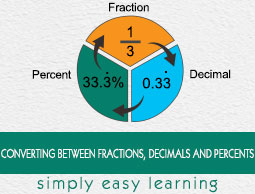
- Converting Between Fractions, Decimals, and Percents
- Home
- Converting a Fraction with a Denominator of 100 to a Percentage
- Converting a Percentage to a Fraction with a Denominator of 100
- Finding the Percentage of a Grid that is Shaded
- Representing Benchmark Percentages on a Grid
- Introduction to Converting a Percentage to a Decimal
- Introduction to Converting a Decimal to a Percentage
- Converting Between Percentages and Decimals
- Converting Between Percentages and Decimals in a Real-World Situation
- Converting a Percentage to a Fraction in Simplest Form
- Converting a Fraction to a Percentage: Denominator of 4, 5, or 10
- Finding Benchmark Fractions and Percentages for a Figure
- Converting a Fraction to a Percentage: Denominator of 20, 25, or 50
- Converting a Fraction to a Percentage in a Real-World Situation
Converting Between Percentages and Decimals in a Real-World Situation
In this lesson, we are solving real world problems related to conversion between percentages and decimals.
Lizzy bought some fabric that was 1.75 meters long. How could this be written as a fraction?
Solution
Step 1:
To convert the decimal to a fraction we multiply and divide by 100
$1.75 = \left ( \frac{1.75}{100} \right) \times 100 = \frac{(1.75 \times 100)}{100} = \frac{175}{100}$
Step 2:
Reducing to lowest terms
$\frac{175}{100} = \frac{7}{4}$
So, 1.75 = $\frac{7}{4}$
Kylie pays tax at the rate of 25% of her income. What fraction of Kylie’s income is this?
Solution
Step 1:
By definition of a per cent, for any whole number x, x% = $\frac{x}{100}$
Step 2:
To convert the percentage to a fraction, from definition x% = $\frac{x}{100}$.
25% = $\frac{25}{100}$
Reducing to lowest terms
$\frac{25}{100} = \frac{1}{4}$
So, 25% = $\frac{1}{4}$
Laura bought a coat in the January sales with $\mathbf{ \frac{1}{5}}$ off the original price. What percentage was taken off the price of the coat?
Solution
Step 1:
The fraction off the original price = $\frac{1}{5}$
Step 2:
To convert the fraction to percentage, multiply and divide it by 20
$\frac{(1 \times 20)}{(5 \times 20)} = \frac{20}{100}$
Step 3:
By definition of percentage
$\frac{20}{100}$ = 20%
So, $\frac{1}{5}$ = 20%
To Continue Learning Please Login